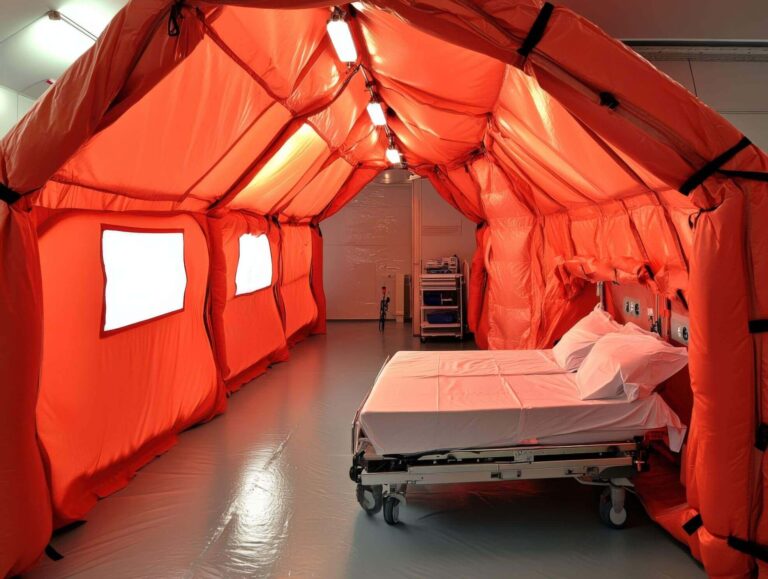When you think about healthcare, hospitals and clinics probably come to mind first. But what happens when those facilities are overwhelmed or when hospitals across the country face unprecedented patient surges? Alternate care facilities are the best solution in these situations. These adaptable, strategically designed spaces have become crucial in managing large-scale medical demands while offering a cost-effective solution for both communities and healthcare systems.
Discover the key roles they play as the healthcare sector shifts to more sustainable and responsive healthcare services.
Rethinking the Boundaries of Medical Care
Hospitals often hit maximum capacity in public health emergency situations. As a result, providers make tough decisions about who gets admitted and who must wait. The strain extends beyond just beds. It affects the medical staff, equipment, and even basic infection control measures.
Imagine an emergency department stretched thin, with patients waiting in hallways or tents for hours just to be triaged. This was the reality during the height of the pandemic and in past mass-casualty incident responses.
To meet growing needs, communities have turned to mobile hospitals —temporary setups that expand medical care beyond traditional settings. These treatment centers reduce hospital overcrowding and maintain essential infection prevention practices through controlled environments.
The Rise of the Alternate Care Facility
An alternate care facility bridges the gap between overwhelmed hospitals and the need for continued access to medical services. Think of it as a “pressure valve” for the health system, designed to treat patients who need moderate to high levels of care but don’t necessarily require full hospitalization.
Such healthcare spaces can be deployed in spaces such as a convention center, group homes, or even residential treatment facilities—essentially any area that can safely accommodate patients with proper design and construction modifications.
During the COVID-19 pandemic, for example, many states collaborated with the US Army Corps of Engineers to rapidly convert public spaces into civilian-operated medical facilities. These were equipped with essential medical equipment, personal protective equipment, and adaptable air-flow systems that met stringent safety standards.
Alternate care sites also extend the reach of healthcare by delivering flexible care delivery solutions, from home health services to medical shelter operations. When managing crisis standards of care situations, they operate under the Incident Command System to ensure coordination, safety, and accountability.
Extending Reach and Flexibility in Community Settings
One of the greatest strengths of alternative care facilities lies in their adaptability. They’re not limited to treating critical patients alone. They can provide skilled nursing care for those recovering from surgery, assist persons with disabilities who need 24-hour protective oversight, or support individuals with behavioral problems.
Disaster medical assistance teams that specialize in emergency management activities and rapid response typically run these facilities. Their role is crucial during both natural disasters and public-health crisis situations, ensuring that medical treatment facilities continue to function without collapsing under pressure.
To maintain order during chaotic times, these setups rely heavily on triage protocols and efficient infection control systems. Proper shelter decontamination measures, combined with strong leadership structures, allow them to operate seamlessly alongside permanent hospitals.
Bringing Healthcare Closer to the People
Alternative care facilities provide much-needed health services in many underserved communities. As such, local agencies can deploy medical aid stations in rural areas, temporary shelters, or disaster zones. In fact, at least 2.8 million uninsured Americans benefited from mobile medical units in 2022, underscoring the effectiveness of this approach in closing care gaps.
By bridging care disparities, these centers contribute to long-term savings for healthcare systems. They prevent unnecessary hospital admissions, shorten recovery times, and minimize the costs associated with hospital overcrowding—all while improving outcomes for vulnerable groups.
Alternate Care and Hybrid Models: Evolving the Future of Healthcare
Alternate care isn’t just a stopgap solution. It’s shaping the next wave of hybrid care. By integrating in-person and remote medical services, healthcare systems can maintain continuity even when physical facilities are under strain. This network comprises call centers, telehealth platforms, and mobile units, providing a combination of remote consultations and on-site treatment.
These innovations reduce burdens on clinics and urgent care centers during emergencies. Diverting patients to alternate setups benefits inpatients needing intensive monitoring or highly functional clinical care.
Building a More Responsive System
If there’s one lesson the world learned from recent years, it’s that preparedness is key. Healthcare systems that can help prepare for disasters are those that maintain resilience in the face of uncertainty. Alternate care sites are an essential part of that readiness. They enable healthcare networks to rapidly activate flexible infrastructure, ensuring uninterrupted medical care delivery during crises.
For instance, these facilities can serve as stabilization points when wildfires or hurricanes disrupt hospital operations. Emergency management activities often include deploying medical shelter operations where medical staff can continue providing skilled nursing care, basic diagnostics, and infection control measures even in compromised environments.
The role of alternate care facilities is not limited to emergencies either. They can support long-term care for patients with chronic disabilities, assist in rehabilitation efforts, and even serve as extensions of residential treatment facilities.
A Blueprint for Sustainable Healthcare Systems
From a business perspective, investing in alternate care infrastructure makes sense. These facilities reduce operational costs, extend service reach, and improve system resilience.
Integrating alternate sites with established networks ensures that medical care continues seamlessly, even when demand spikes unexpectedly. With the support of emergency department personnel and cross-trained teams, healthcare systems can pivot faster and operate more efficiently under pressure.
More than providing temporary fixes, alternate care facilities can become long-term solutions for a more flexible, inclusive, and sustainable healthcare. They combine the best of adaptability, preparedness, and compassion—qualities that every community needs to thrive, regardless of the challenges that lie ahead.

